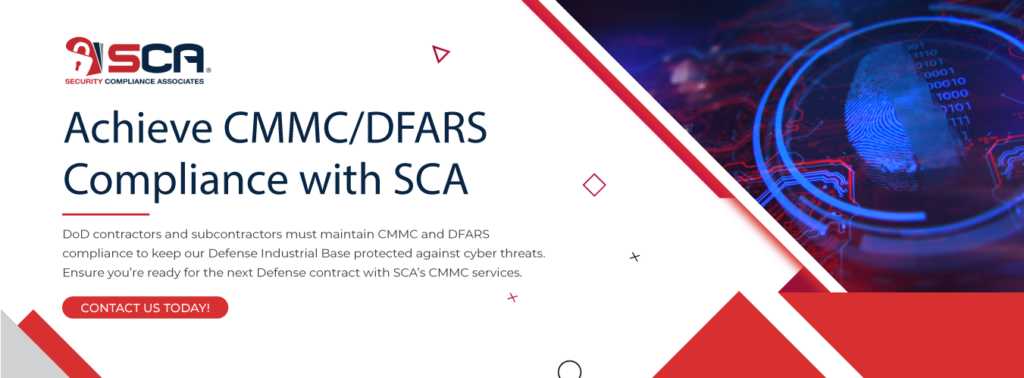
- August 31, 2023
- Brian Fischer
- 696 Views
- 0 Likes
- Blog, Compliance, DFARS
Understanding the DoD Cyber Workforce: What to Know Now
When the boundaries between physical and virtual domains blur, the importance of cybersecurity cannot be overstated. Nowhere is this more evident than in the Department of Defense (DoD) operations, an entity responsible for protecting the nation both on and offline.
So, let’s dive into the world of the DoD Cyber Workforce. And explore its significance, responsibilities, strategies, and the frameworks that support its mission to fortify national security.
The DoD Cyber Workforce constitutes a specialized group of professionals committed to securing the nation’s digital assets, infrastructure, and operations against evolving cyber threats. This workforce extends across a spectrum of roles, encompassing analysts, engineers, specialists, and managers who work collaboratively to maintain the cyber resiliency of the United States. SCA is here to help decode DoD procurement for contractors and help contractors ensure that their contracts will be renewed.
The DoD Cyber Workforce: What Is It?
Cybersecurity breaches and data compromises can potentially disrupt businesses, governments, and even individuals globally. Organizations and governments must invest in a robust cyber workforce management strategy to counter these threats. This article delves into the essential components of such a strategy, encompassing the Cyber Workforce Framework, Directive 8140, and the Cybersecurity Maturity Model Certification (CMMC) role.
Cyber Workforce Framework and Strategy
To ensure a comprehensive and effective approach to cybersecurity, organizations must establish a clear framework for their cyber workforce. This framework outlines the roles, responsibilities, and skill sets required to defend against cyber threats. A well-defined cyber workforce strategy considers the evolving threat landscape, technological advancements, and the organization’s unique needs.
The cyber workforce framework typically includes:
- Roles and Specializations: Identifying various roles within the cyber workforce, such as security analysts, penetration testers, incident responders, and more. Each role comes with specific skill requirements and responsibilities.
- Skill Development: Providing continuous training and development opportunities to keep the cyber workforce up-to-date with the latest cybersecurity tools, techniques, and best practices.
- Recruitment and Retention: Attracting and retaining top talent by offering competitive compensation, opportunities for career advancement, and a supportive work environment.
- Diversity and Inclusion: Recognizing the importance of diversity in perspectives and experiences to enhance problem-solving and innovation within the cyber workforce.
Related Content: DFARS Compliance: Intro Guide for DoD Contractors
Directive 8140: Cyberspace Workforce Management
Directive 8140, issued by the U.S. Department of Defense (DoD), outlines the guidelines for managing the cyberspace workforce. This directive aims to standardize the skills, training, and qualifications required for various cyber roles within the DoD. By establishing clear certification and training pathways, Directive 8140 ensures that the DoD’s cyber workforce possesses the necessary expertise to defend against cyber threats effectively.
Key components of Directive 8140 include:
- Cyber Workforce Categories: The directive categorizes the cyber workforce into different levels, each with specific skill requirements and job functions. This categorization enables the DoD to tailor training and certification programs to different skill levels.
- Certification Standards: Directive 8140 specifies the certifications and qualifications for various cyber roles. These certifications provide a standardized benchmark for evaluating the expertise of individuals within the workforce.
- Continuing Education: Recognizing the dynamic nature of cybersecurity, the directive emphasizes the importance of ongoing education and professional development to maintain up-to-date skills and knowledge.
CMMC incorporates various cybersecurity maturity levels, each with specific practices and processes that organizations must implement. These levels range from basic cybersecurity hygiene to advanced practices that can withstand sophisticated cyber threats. Organizations adhering to CMMC requirements demonstrate their commitment to safeguarding sensitive information and contributing to national security.
Effective cyber workforce management is critical to any organization’s cybersecurity strategy. The Cyber Workforce Framework provides a structured approach to role definition and skill development, while Directive 8140 ensures that the necessary expertise is present within the workforce. CMMC extends this focus to the organizational level, promoting a comprehensive approach to cybersecurity readiness. By investing in a skilled cyber workforce and adhering to established frameworks, organizations contribute to a safer digital landscape for all.
SCA is here to help you leverage your cyber workforce. Our experience with Department of Defense contractors puts us in an excellent situation to assist organizations deploying a cyber workforce and who are pursuing CMMC. From CMMC Readiness through our Centurion ESO (Executive Security Officer) program and ancillary services. We look forward to working with you!


